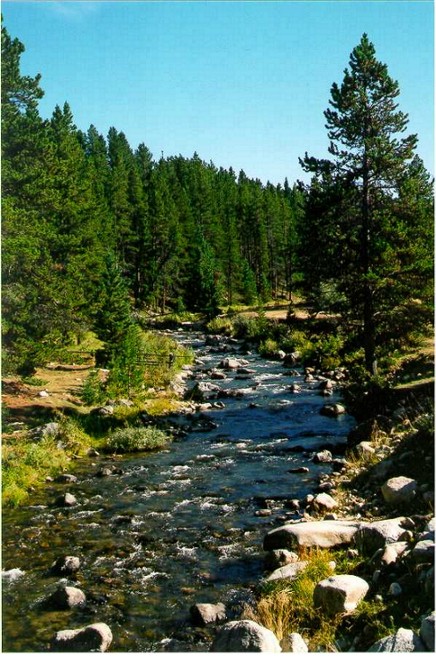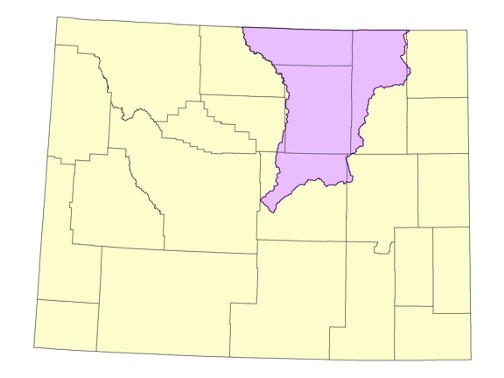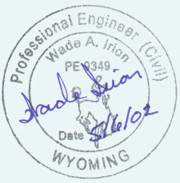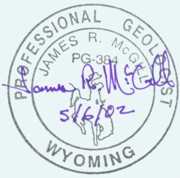Wyoming State Water Plan
Wyoming State Water Plan
Wyoming Water Development Office
6920 Yellowtail Rd
Cheyenne, WY 82002
Phone: 307-777-7626

Wyoming Water Development Office
6920 Yellowtail Rd
Cheyenne, WY 82002
Phone: 307-777-7626





Prepared for:
Wyoming Water Development Commission
Basin Planning Program
Prepared by:
HKM Engineering Inc.
Lord Consulting
Watts and Associates


February 2002
Project Scope
The Powder/Tongue River Basin Plan document is one of four River Basin Plans thus far completed by the Wyoming Water Development Commission as authorized by the Wyoming Legislature in 1999. The plans for the Bear River Basin and Green River Basin were completed in 2001, and the plan for the Northeast Wyoming River Basins is being completed concurrently with the Powder/Tongue River Basin Plan. The Wind/Big Horn River Basin and the Snake/Salt River Basin plans were initiated in 2002 and the plan for the North Platte River will commence in the near future. It is the express desire of the program to revisit and update the basin planning documents every five years.
This planning document presents current and projected future uses of water in Wyoming's Powder/Tongue River Basin. Uses inventoried and analyzed in this plan include agricultural, municipal, industrial, environmental, and recreational. Surface and ground water uses are both described as is overall water quality. Given current uses, the availability of surface water and ground water to meet estimated future requirements is analyzed. The current institutional and legal framework of water development and management is presented.
The primary products of this planning study are technical memoranda prepared for the large number of topics addressed in the plan. These memoranda provide detailed descriptions of the data collected, source references, analyses performed, tools developed, and the results of each investigation required to fully explore the water resources within the planning area. The intent of this Executive Summary, and the associated Final Report, is to describe the planning study in sufficient detail for the reader to gain a general understanding of the investigations that were performed and the results of those investigations. For detailed information on a specific topic the reader is directed to the technical memorandum prepared for that topic.
Basin Description
The study area of the Powder/Tongue River Basin Plan includes the drainages of the Little Bighorn River, Tongue River, Powder River, and Little Powder River. These river basins encompass all or part of Sheridan, Johnson, Campbell, Natrona, and Converse counties as well as a small part of Washakie county in north central Wyoming. The planning area is shown on Figure 1.
Climate throughout the Basin varies, but generally follows the pattern of a high desert region. Annual precipitation in the range of 13 to 15 inches is the norm for the majority of the planning area.
The major rivers and streams in the study area include the following:
The Wyoming constitution establishes water in the state to be the property of the state. Consequently, all development and management of water resources in Wyoming is governed by the water laws embodied in the Constitution and Statutes. These water laws are recognized as inviolate in the river basin planning program.
The Yellowstone River Compact of 1950 controls the development and use of water from the Tongue River, Powder River, and Little Powder River. This compact divides the unappropriated flow of the Tongue River, Powder River, and Little Powder River, after needs for supplemental supply for existing rights are met, as follows:
Agricultural Water Use
Irrigated agriculture in the planning area is primarily associated with forage production for the livestock industry. Ranchers depend on irrigated cropland to provide winter feed and summer grazing for their stock. Alfalfa, grass hay, and pasture grass are the dominant crops grown in the planning area. Lesser amounts of small grains and corn are also produced. In total, 161,360 acres of land are actively irrigated in the planning area and the vast majority of these lands are irrigated with surface water.
The depletion of water by irrigation is primarily dependent on the number of acres irrigated, the crop water demands, and the amount of water available to meet these demands. Depletions for wet, normal, and dry years total 194,000 acre-feet, 184,000 acre-feet, and 178,000 acre-feet respectively.
Municipal and Domestic Water Use
There are twenty public water supply entities in the planning area, consisting of incorporated municipalities, districts, and privately owned water systems. Two of the communities obtain water from sources outside the study area. Four of the entities obtain their primary water supply from surface water and consume approximately 2,700 acre-feet per year. The remaining sixteen entities use approximately 500 acre-feet per year of ground water. Domestic use is satisfied by ground water and is on the order of 2,400 to 4,400 acre-feet per year.
Industrial Water Use
Conventional oil and gas production and coalbed methane development constitute the industrial water use in the Powder/Tongue River Basin. The estimated depletion of ground water for these uses is approximately 68,000 acre-feet per year. No water is currently being used in the study area for electric power generation or coal mining. Lake DeSmet has been developed as a surface water supply for future electric power generation, but this source has yet to be utilized.
Recreational Water Use
Recreational uses associated with the water resources of the Powder/Tongue River Basin include boating, fishing, and waterfowl hunting. Although these uses are generally non-consumptive, water-based recreation is enhanced through minimum flow releases from reservoirs, minimum pool levels maintained in reservoirs, and instream flow water rights established on streams. Lake DeSmet, the largest standing water recreation attraction in the Powder/Tongue River Basin, supports skiing, fishing, swimming, boating, and camping.
Environmental Water Use
Environmental uses of water in the Powder/Tongue River Basin are largely non-consumptive. Environmental use topics addressed in this planning study include water administration (minimum flow releases, minimum pool maintenance, and instream flow water rights), environmental concerns associated with water produced by coal bed methane development, and wetland mapping. Concerns expressed by environmental organizations are also presented in the basin plan.
Reservoir Evaporation
The majority of water use from storage reservoirs within the Powder/Tongue River Basin is for irrigation. Evaporation from these storage reservoirs constitutes another consumptive use of water within the planning area. Evaporation from the 14 key storage facilities (generally larger than 1,000 acre-feet) totals 11,300 acre-feet annually.
Current Water Use Summary
The current water uses in the planning area are summarized as follows:
| Water Use | Dry | Normal | Wet | ||||
| (AF/Year) | |||||||
| Surface Water |
Ground Water |
Surface Water |
Ground Water |
Surface Water |
Ground Water | ||
| Agricultural | 178,000 | 200 | 184,000 | 200 | 194,000 | 300 | |
| Municipal | 2,700 | 500 | 2,700 | 500 | 2,700 | 500 | |
| Domestic | --- | 4,400 | --- | 4,400 | --- | 4,400 | |
| Industrial1 | --- | 68,000 | --- | 68,000 | --- | 68,000 | |
| Recreation | Non-consumptive | ||||||
| Environmental | Non-consumptive | ||||||
| Evaporation | 11,300 | 11,300 | 11,300 | ||||
| TOTAL | 192,000 | 73,100 | 198,000 | 73,100 | 208,000 | 73,200 | |
| Notes: | 1. Includes conventional oil and gas production water and CBM production water. |
Available Surface Water
The determination of available surface water was broken down into the following seven tasks for this study:
Water availability spreadsheet models were developed for the following six sub-basins within the Powder/Tongue River Basin planning area:
The models do not explicitly account for water rights nor are the models operated based on these legal constraints. Further, the models do not associate supplemental reservoir releases to the specific water users. However, by calibrating the models to historical streamflows at gaged locations, the models can be used to generally represent existing operations. Model inputs can then be modified to estimate the impacts associated with potential future water projects.
The total annual flow, physically available in excess of current Wyoming water demands, is summarized as follows:
| Subbasin | Hydrologic Condition | ||
| Wet Years | Normal Years | Dry Years | |
| Little Bighorn River | 152,000 | 113,000 | 81,000 |
| Tounge River | 473,000 | 326,000 | 218,000 |
| Clear Creek | 213,000 | 124,000 | 80,000 |
| Crazy Woman Creek | 69,000 | 32,000 | 16,000 |
| Powder River | 547,000 | 324,000 | 194,000 |
| Little Powder River | 48,000 | 12,000 | 3,000 |
The Yellowstone River Compact of 1950 governs the allocation of the waters in the Powder River and Tongue River between the States of Montana and Wyoming.
The methodology used in the current study to evaluate water availability under the Yellowstone River Compact was coordinated through the Wyoming State Engineer's Office and relies heavily on previous work performed by each of the two States. Wyoming's estimated compact allocation under each of the three hydrologic conditions is summarized as follows.
| Hydrologic Condition | Tounge River Basin | Powder River Basin | |
| Conservative Estimate |
Liberal Estimate | ||
| Wet Years | 163,000 | 189,000 | 211,500 |
| Normal Years | 90,000 | 117,000 | 131,100 |
| Dry Years | 40,000 | 67,000 | 74,300 |
Available Ground Water
The objectives of this element of the study were as follows:
The significance of ground water in the planning area is demonstrated by the 16,432 active ground water permits (as of December 31, 2000) within the planning area. Because of the dynamic nature of coalbed methane (CBM) development, the inventory of permitted CBM wells was updated to reflect data as of December 31, 2001. The number of permits for each use category are summarized below:
General conclusions regarding ground water development potential of four of these five major aquifer systems are summarized below:
To assess future water needs in the Powder/Tongue River Basin, projections of water demands were developed for major water use categories through the year 2030. Surface water uses were projected for low, moderate, and high growth scenarios.
Future demands for irrigation water are largely dependent upon factors such as crop and livestock prices and the cost of developing new water storage and delivery systems. The low growth scenario projects no changes in those factors relative to current conditions, and thus no increase in irrigation water use. The moderate and high growth scenarios project moderate increases in irrigation water use based upon projected increases in crop and livestock prices and the possibility of increased state assistance in developing new irrigation water supplies. For the moderate growth scenario, consumptive irrigation water use rises from a current level of 184,000 acre-feet annually to 194,000 acre-feet annually by the year 2030, an increase of six percent. For the high growth scenario, consumptive use rises to 205,000 acre-feet annually by 2030.
Municipal and Domestic Use Projections
The larger municipalities in the Powder/Tongue River Basin rely upon surface water sources to meet their needs. Their future municipal water demands are closely tied to future population levels in the planning area. Three population-forecasting methods were used to develop low, moderate, and high growth population projections for communities in the Powder/Tongue River Basin through the year 2030. Based upon these projections, municipal surface water use is expected to grow from a current level of 2,700 acre-feet annually to 3,200 acre-feet annually by 2030 for the low growth scenario. For the moderate and high growth scenarios, the increases are to 3,500 and 3,800 acre-feet respectively. Domestic water needs in the Powder/Tongue River Basin are typically satisfied by groundwater. Projections developed for this plan Indicate that domestic water use is expected to increase from a current level of about 4,800 acre-feet annually to between 5,500 and 6,400 acre-feet by the year 2030.
Industrial Use Projections
There are no large industrial users of surface water in the planning area. Industries such as oil and gas development and mining all make use of relatively small amounts of groundwater. That situation could change in the future with the construction of coal-fired electric generating facilities and coal-conversion facilities designed to increase the heat content of coal. For the low growth scenario, no such developments are projected to take place. For the moderate and high growth scenarios, however, industrial surface water demand is expected to grow to between 17,000 and 35,000 acre-feet annually by 2030.
Recreation Use Projections
Fishing is the predominant water-based recreational activity in the planning area, and angers currently engage in approximately 272,000 activity days of fishing each year. Projections developed for this plan indicate fishing demand is expected to increase to between about 330,000 and 430,000 activity days annually by the year 2030. The Powder/Tongue River Basin is well endowed with both stream and stillwater fisheries, which are generally adequate to meet current demands. These resources will come under increasing pressure as recreational demand increases as a result of population growth and increases in tourism.
Environmental Use Projections
Environmental water requirements are not directly related to changes in population or tourism, but instead reflect human desires concerning the type of environment in which people want to live. These desires are reflected in environmental programs and regulations promulgated by elected representatives at the local, state and federal levels. Examples include Wyoming's instream flow statues and minimum reservoir pools dedicated to fish and wildlife enhancement. While generally non-consumptive, environmental needs can conflict with consumptive water uses in some situations. No significant conflicts between environmental and consumptive water uses are projected for the Powder/Tongue River Basin.
Compact Considerations
Wyoming's use of surface waters from the Powder and Tongue Rivers is subject to limitation by interstate compact. Projected surface water demands were contrasted with estimates of Wyoming's remaining allocations of water in the Powder and Tongue River sub-basins. No potential conflicts were identified.
Demand Projections Summary
The projected surface water uses are summarized in the following table for the low, moderate, and high growth scenarios.
Summary of Current and Projected Surface Water and Ground Water Uses
| Use | Current | Projected Use by Growth Scenario (Acre-feet/Yr.) | ||||||
| Low | Moderate | High | ||||||
| Municipal/Domestic | 2,700 | 3,200 | 3,500 | 3,800 | ||||
| Industrial | (included in municipal) | (included in municipal) | 17,000 | 35,000 | ||||
| Irrigation | 184,000 | 184,000 | 194,000 | 205,000 | ||||
| Evaporation | 11,300 | 11,300 | 11,300 | 11,300 | ||||
| Recreational | (non-consumptive) | |||||||
| Environmental | (not estimated) | |||||||
| Total | 198,000 | 198,500 | 225,800 | 225,100 | ||||
Future Water Use Opportunities
This river basin plan quantifies water resources available for development and use and identifies current and projected future water needs in the Powder/Tongue River Basin. The concluding task of this study is to identify future water use opportunities that can be implemented to satisfy the water demands in the Little Big Horn River, Tongue River, and Powder River Basins in Wyoming. The list of potential water use opportunities provided is intended to assist individuals and organizations in finding ways to meet their specific needs.
To further assist the users of this list in identifying potential opportunities to satisfy their demands, a methodology is presented that can be employed to evaluate a specific opportunity on the list relative to similar and related opportunities. The suggested methodology evaluates opportunities according to the likelihood they are desirable, functional, and capable of receiving the support required for development. By using the list of future water use opportunities and employing the evaluation methodology, individuals and organizations will have "a place to start" in their investigation.
The procedure used to complete this task consisted of four steps:
The success of a water development project is also dependent on the ability of the source to meet the water quality needs of the proposed uses. In addition, the project itself must protect existing and potential uses of waters of the State. As a part of this river basin planning process a description of the water quality character of the Powder/Tongue River Basin was developed. The plan also describes contemporary water quality programs initiated to protect and enhance the quality of surface water in the planning area. Finally, the primary issues related to the quality of water in the planning area are detailed in industrial, agricultural, and municipal categories.